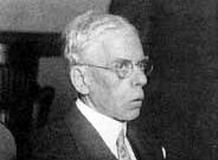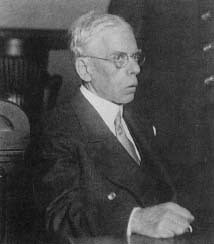Henry Colin Campbell Trial: 1929
law.jrank.org
Defendant: Henry Colin Campbell
Crime Charged: Murder
Chief Defense Lawyer: Francis A. Gordon
Chief Prosecutor: Abe J. David
Judge: Clarence E. Case
Place: Elizabeth, New Jersey
Date of Trial: June 9-13, 1929
Verdict: Guilty
Sentence: Death
SIGNIFICANCE: A curious case in which claims
of amnesia were used by a killer to demonstrate his mental instability
and hopefully keep him off death row.
When the charred remains of a woman—her skull blasted
by a bullet—were found beside a highway in Cranford, New Jersey, on
February 23, 1929, the crime left local police baffled. For six weeks
they struggled to identify the victim, until a routine circular came
back from Greenville, Pennsylvania, saying that the corpse sounded very
much like a local woman, Mildred Mowry, who had been missing since early
February. Investigation revealed some bizarre recent developments in the
life of the middle-aged widow. In August 1928, she had apparently
married a 60-year-old doctor named Richard Campbell, whom she had met
through a matrimonial agency. Just one day after the ceremony, Campbell
had convinced Mildred to deposit her life savings of $1,000 in his bank
account; then, claiming pressure of work, he took off for California.
Mildred labored to keep in touch by mail, but as the
silences between letters grew longer, concern overwhelmed discretion and
she set out to track down her errant husband.
And then she disappeared.
Far from being on the West Coast, Campbell had moved
no farther than Elizabeth, New Jersey. He was living under his real name
of Henry Colin Campbell, with his genuine wife and family, when police
came knocking on his door on April 11, 1929, with an arrest warrant for
murder. Campbell's claims to be a doctor were as spurious as the
marriage he had entered into with Mildred Mowry, and it soon became
apparent to the police that not only had they trapped a career criminal,
but possibly a serial killer, as well.
Fit To Plead
When the case against Campbell came to court June 9,
1929, the first day was given over to evidence from two alienists, or
psychologists, Drs. Gus Payne and Lawrence Collins, both of whom
declared that the defendant, although clearly affected by his morphine
addiction, was legally fit to stand trial.
This went to the heart of the trial: for at no point
did Campbell attempt to deny that he had first shot and then burnt
Mildred—the murder weapon, a. 38 automatic, was recovered from his home—only
that he had no recollection of having done so. Prosecutor Abe J. David
ridiculed this as nonsense and read aloud a confession made by Campbell
shortly after his arrest, in which he admitted killing Mildred to
conceal his bigamous marriage. David also offered into evidence 17
letters written by Campbell to the murdered woman. Together, they formed
a heartless catalog of deception and manipulation, a clear blueprint of
the way in which Campbell traded on Mildred's loneliness and
vulnerability to line his own pockets. And, said David, when the hapless
Mildred eventually ran Campbell to ground and confronted him about the
situation, he had shot her.
Guided by defense counsel Francis A. Gordon, Rosalie
Campbell, the defendant's genuine wife, fought hard to save her
beleaguered husband. In moving terms she described his downward spiral,
telling how life had been "wonderful always" at first, but after moving
from Chicago to Maryland, "he began to fall. He had headaches and began
to lose weight. Then he started taking something for his headaches… He
took the medicine not very frequently at first, then more frequently."
During the few months prior to the murder, she said,
Campbell's nervousness and irritability appeared to be building toward a
peak, and for no apparent reason he had begun carrying a gun.
When Campbell took the stand he looked like a man at
the end of his tether. Small and shrunken, with yellow skin and straggly
white hair, he trembled visibly behind rimless glasses as Gordon led him
through his testimony. After repudiating the confession as a police
fabrication, he claimed he had visited Mildred on February 21 in order
to return the money she had lent him. First, though, he needed to raise
funds, and this meant driving Mildred to several banks, none of which
would help him. In between stops, he said, he told Mildred of his secret
life. She told him that she did not want him to leave his wife and
children. Campbell maintained that throughout the journey he kept dosing
himself with drugs to "keep my nerve from going to pieces." Then, he
said, everything went blank.
"Do you have any recollection of shooting Mrs. Mowry
and burning her body?" asked Gordon.
"No, I don't remember doing so."
Prosecutor David wasn't convinced. As the precursor
to a blistering crossexamination, he thrust two application forms for "friendship
clubs" in front of the witness. Campbell cringed when he saw them. He
had filled them out before meeting Mildred, and in one, under the
heading "Disposition," he had answered, "The best ever if well treated,"
and on both he had described his health as "good." Hardly, sneered
David, the responses of a man who was seriously ill. And what about his
listed preference—"Widows with no children"—evidence, surely, of someone
with an ulterior motive?
Campbell lowered his head and said nothing, utterly
defeated.
In closing, David went over Campbell's original
confession point by point, saying how it matched in every detail the
known circumstances of the crime, and he implored the jury to set aside
both sympathy and any scruples they might have against capital
punishment. Campbell was a thrice-married rogue, he said, with a string
of convictions for fraud and forgery that had led to numerous jail terms.
In his opinion, the accused man's wife and three children would be "better
off without him."
Justice Clarence E. Case, in his final charge to the
jury, went to the question of insanity by saying:
If the defendant was conscious of the nature of his
act he cannot be acquitted. The law does not recognize that form of
insanity in which the faculties are so affected as to render a person
suffering from it unable to control those urges … In medicine a man
who steals and cannot control his stealing is called a kleptomaniac,
in law he is regarded as a thief and punishable as such. If the
accused sets up a defense of insanity the burden of proof lies with
him; he must overcome the legal presumption of his sanity.
On June 13, 1929, the jury found Campbell guilty of
first degree murder, with no recommendation for mercy, and he was
sentenced to death.
In all probability Mildred Mowry was not Campbell's
first victim. Just one year earlier, a New York governess named Margaret
Brown had suddenly left her job to marry a mysterious "doctor" she had
met through a matrimonial agency, taking with her $7,000 in savings. Her
body, also shot and burned, was found just 15 miles away from the spot
where Mildred Mowry met her death. While the similarities were marked,
it proved impossible to fix the blame for that murder on Campbell. Not
that it mattered. On April 17, 1930, the philandering "doctor" went on
his final date—with the electric chair.
—Colin Evans


